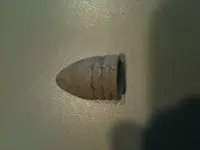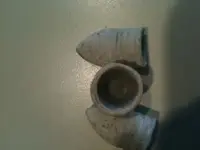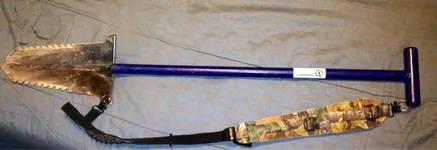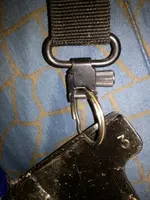I searched a little and found two possibilities. It could be a Watervilet Arsenal .62 caliber or maybe a Charlestown Arsenal .63 caliber. Maybe a more thorough search could turn up some info on your bullet.
I am enclosing a reply found on another forum that I found very interesting reading. I hope Y'all think the same. I was unable to copy the picture but here is a link if you want to look at it.
http://cwbullet.org/bullet-relic-forum/showthread.php?t=6334&pagenumber=
Default Minie Ball Calibers.
In response to Evan’s inquiry about larger than .58 / .577 calibers minies here are some general observations.
In 1855 the U. S. adopted the diameter of .5775 by 1.05 for its standard .58 caliber conical rifle ball.
As the arsenals turned out rifled muskets of .58 calibers I believe that adhering to the prescribed .5775 resulted in an extremely tight fit for the ball when loaded thus encouraging manufactures to relax the diameter to a more accommodating size.
Anyone who has measured recovered minies has found that they measure anywhere from .555 to .580, the majority being .565 to .570 in diameter, bullet shown to the right.
Union arsenal machine made bullets are more consistent with this sizing while Confederate cast bullets seem to vary greater in diameters.
Many believe that bullets measuring above .580 were intended for a .59 caliber musket but most experts consider these to be manufactured out of tolerance by arsenal bullet producing subcontractors and not rejected by the arsenal before rolled into cartridges thus being discarded by soldiers in the field as a potential jamming problem to load.
The crude Confederate bullet shown in the center measures .585 to .590 in diameter and some would say it is a 60 caliber but I think it could be the result of a bad .58 caliber mold maker.
Two notable larger calibers are found in the Thomas Handbook; the early war Watervliet Arsenal .62 caliber minie for French rifles and the Charleston Arsenal .63 caliber minie issued for the English Brunswick 2 groove rifles.
These are examples of sanctioned manufacture by governing bodies to accommodate European imports as the American Civil War was a golden opportunity for the Europeans to dump at a profit quantities of considered obsolete weapons abroad.
Another factor is the early war weapons carried into battle privately by the Confederacy in other non-standard calibers of which very little is documented to identify a recovered bullet as to just what weapon it was intended for.
The common Picket / Country minies are the more prevalent of these odd ones as well as those arms sold to the Union by Horace Dimick.
The bullet pictured to the left is a good example of a western unknown minie of .630 in diameter; the difference is that it was made in the three grooved military minie pattern as opposed to the more generic tear drop pattern of commercial rifles.
Several examples of odd minies appear in the western areas that were undeniably used in the war but have little to offer as to their origin.
A lot of these can be attributed to Confederate short runs of bullets produced in facilities that came and went in the course of advancing Union forces.
Smaller diameters appear more frequently than larger diameters do in multi-groove and Enfield pattern bullets.
Often measuring down to .510 in diameter many people believe that they are .52 calibers.
All of these of substantial cavity designs are for a .54 caliber rifled musket.
I know of no .52 caliber rifled musket used in the war that could account for the plentiful number of minies often called such names as Austrian, sharpshooter, Forrest Enfield’s and Green carbines.
One exception to the standard musket calibers does bare some validity and that is the .55 caliber.
Loads of European shot out .54 caliber Lorenz rifles were imported into the U. S. and there are records of these being re-bored to .55 calibers to recondition them to a usable service condition.
Any wide acceptance of this caliber is a bit blurry but a lot of domestically made minies that measure .54 to .55 exist; possible oversize manufacture of .54 caliber minies or possibly a similar re-bore effort was implemented to utilize older 1841 Mississippi rifles used in the Mexican War?
A line of distinction is not always obvious between what was produced by sanctioned governing bodies of the ordinance departments and what actually showed up on the battle grounds.
Relic hunters are apt to find pre-war, war time, post war to modern made minies in most all areas affected by the conflict amongst each other so good luck on a correct identification of your finds.






